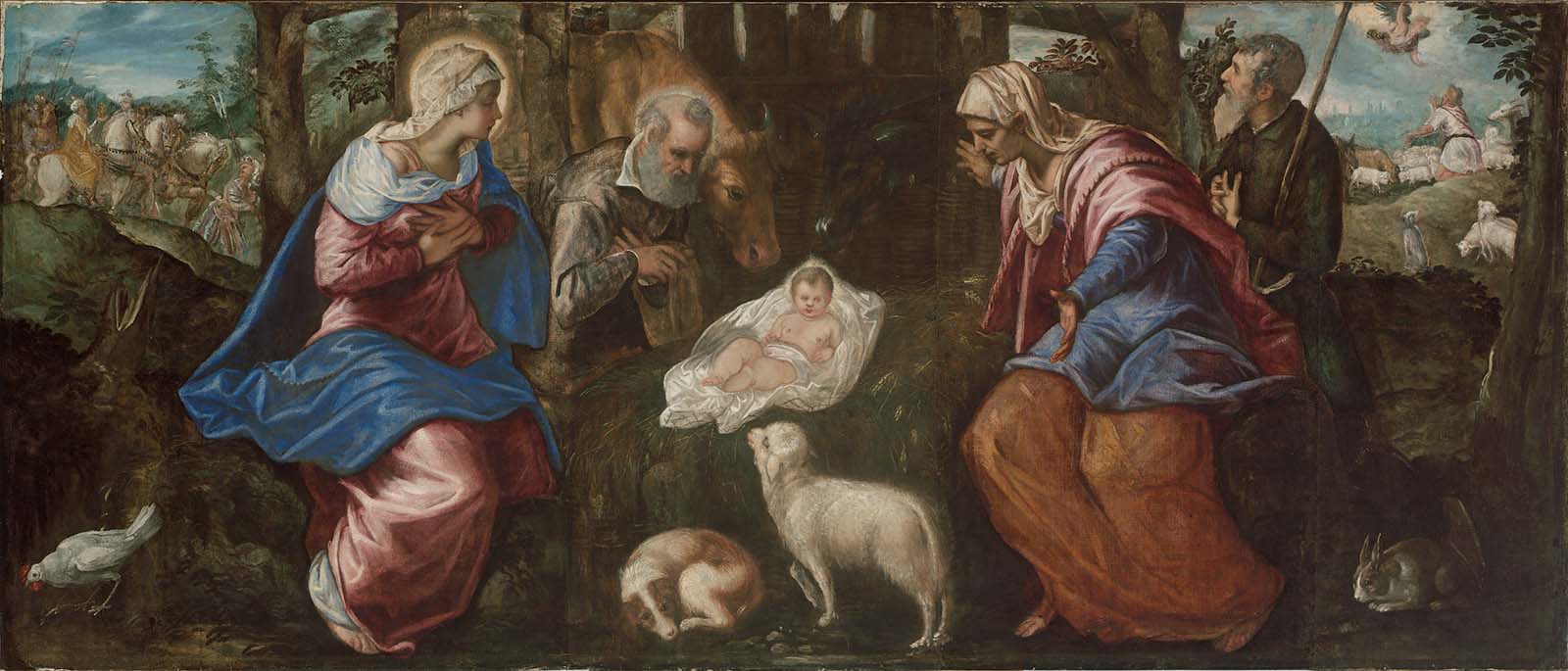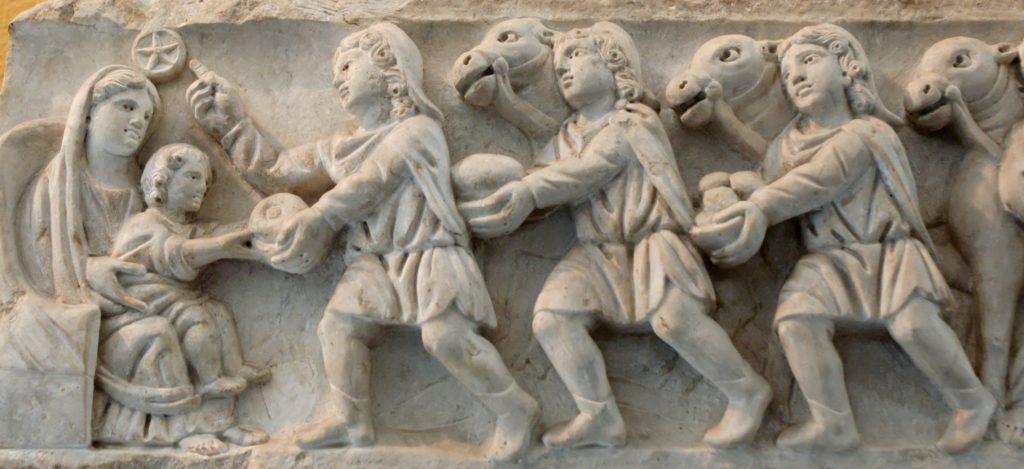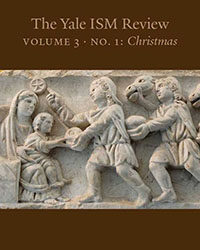Felicity Harley-McGowan and Andrew McGowan
The story of the birth of Jesus Christ is familiar, both from the biblical narratives and from iconography that has become ubiquitous in church decoration and widely circulated on Christmas cards: a mother and father adoring their new-born child, an ox and an ass leaning over the child, a star hovering above this scene, angels, shepherds with their sheep in a field, and luxuriously clad “wise” men or kings approaching the child with gifts.
All these elements are included by the Venetian artist Jacopo Tintoretto in a painting which started in his workshop in the late 1550s, and for much of its life hung above the altar of a church in Northern Italy (Fig. 1). In addition, Tintoretto imagines other figures at the scene. With Mary and Joseph at the manger, he includes a second pair of human figures, perhaps the parents of the Virgin: Anna and Joachim. The artist also inserts less traditional animals in the foreground: a chicken and a rabbit, and a dog curled at the foot of the manger.

Fig. 1. Jacopo Tintoretto (Jacopo Robusti), The Nativity, Italian, late 1550s (reworked, 1570s), oil on canvas, 155.6 x 358.1 cm. Museum of Fine Arts, Boston: gift of Quincy Shaw, accession number 46.1430. Photograph © 2016 Museum of Fine Arts, Boston.
Yet the rich details of the scene that Tintoretto depicts, many of which are now well known in popular renditions, were not present in the first depictions of the Nativity. Even the elements derived directly from the gospel narratives of Matthew and Luke were slow to appear in visual renderings. Between those early scriptural accounts and the formation of even a basic manger scene lie some centuries during which Christian devotion and depiction developed.
So too a ritual observance of Christmas in the liturgical life of the Church does not belong to the earliest years of the Christian movement, but took until the fourth century to appear clearly. The emergence of Christmas as we know it, nativity scene and festivity and all, required its own long historic Advent wait.
Infancy Narratives
The Gospel that is usually considered oldest, that of Mark, has no reference to the birth of Jesus. Luke’s and Matthew’s Gospels, both making use of Mark’s version, add stories of the birth of Jesus that have points of contact but also differ significantly in the details. While the familiar shepherds, angel choirs, and the manger come from Luke, Matthew provides the Magi and the guiding star. Matthew’s angelic messenger visits Joseph. Luke’s more famously comes to Mary. What is perhaps the last-written of the canonical Gospels, that of John, has a more abstract or conceptual Incarnation account, wherein the eternal Word becomes flesh.
By the time we can point to material evidence in early Christian art, both narratives were well known, but the features that caught the attention and interest of artisans and their sponsors were not drawn evenly from across this set of stories.
Beginnings: Third Century
There is no surviving evidence to suggest that Christians used art to express the central tenets of their faith before around 200 CE. During the third century, however, they did begin to experiment with visual images, decorating their tombs, churches, as well as household objects and personal items, with pictorial decoration. Stories from the Old and New Testaments served as important sources of inspiration in this process.
Christians selected particular subjects for illustration with evident care; and it may be surprising to us that, judging from the third-century images that survive, they were not initially very interested in Luke’s manger scene. They were more inclined to Matthew’s account, with its visit of the Magi. These mysterious Gentiles to whom Christ was revealed were frequently portrayed in art by the middle of the third century, and according to a standard iconographic pattern: following the unusual star, they were shown bearing their gifts and moving in rhythmic procession towards Mary, who is shown seated and ready to receive the exotic visitors, with the child on her lap.
The earliest surviving versions of the scene are found in funerary settings, on the walls of Roman catacombs or on marble sarcophagi. In one of the oldest Christian cemeteries, the Catacomb of Priscilla, a very early depiction is found prominently displayed above an arch, with the procession cleverly following the curve of the architectural feature (Fig. 2). Dating from the late third or early fourth century, the painting attests that the Magi were now understood to be three in number; although Matthew had not counted them, three gifts for the Child are mentioned: gold, frankincense and myrrh. The Magi dominate this scene, their importance stressed not only by the fact that they occupy the larger part of a composition as a whole but in that they are its central axis: the viewer’s eye is drawn upward, directly to the leading figures in the procession, who occupy the space at the apex of the arch. The emphasis is on their movement—the active seeking of God in his incarnate Son.
Fig. 2. Adoration of the Magi. Wall painting from the Capella Graeca, Catacomb of Priscilla, Rome. Late third or early fourth century CE. (Image no longer available)
A marble sarcophagus fragment excavated from the cemetery of Saint Agnes in Rome gives even greater solemnity and prominence to the procession with the addition of three camels and the star, to which the first Magus dramatically points (Fig. 3). They approach the seated Virgin while Jesus, depicted as a small child, leans forward and stretches out his hands to grasp the first of the three gifts.

Fig. 3. Adoration of the Magi. Fragment from a Roman sarcophagus, fourth century. From the cemetery of Saint Agnes, Rome. Vatican Museums, Museo Pio Cristiano, inv. 31459.
In such scenes, the viewer is not just witness to the solemn act of seeking and discovery, but a participant. The ancient Christian may have recognized in these gift-bearers the posture and gestures given in Roman art to figures who offer or exchange gifts. In depictions of ancient Greek and Roman gift-giving practices, the act and choice of gift were important in furnishing information about both giver and recipient; and the postures adopted in Roman imperial ceremony for the worship of an Emperor or other ruler seem to provide a pictorial model for the representation of the Magi.[1] Identifying with or recognizing such an outward act of homage, the viewer could enter into the Nativity story through the wise visitors, worshipping God manifest on earth in the Child.
The Magi’s gift-giving recalled the presentation of tributes and gifts by kings from distant shores in Psalm 72:10, and by the third century, Tertullian (Against Marcion 3.13) writes “The East considers the Magi almost as Kings.” By the sixth century the Magi had been given the names Balthasar, Melchior, and Gaspar.[2] They are so named in a sixth-century mosaic from Sant’Apollinare Nuovo in Ravenna, Italy, where they are depicted as sumptuously dressed Eastern figures leading a long procession of female martyrs towards Mary and Jesus. The influence of imperial iconography is striking. Against a shimmering gold background, the enthroned Mother and Child now occupy more space than the Magi, and are the pictorial focus. Mary, luxuriously robed and majestically seated on a gem-studded throne, with flowering plants at her feet, is portrayed as the Mother of God. Depicted in strict frontality, and flanked by her court of four angelic attendants, she ceremoniously presents the child, both to the Magi and the viewer, as God incarnate (Fig. 4).[3]
Fig. 4. Adoration of the Magi. Detail from the mosaic decoration of the nave (north side), Church of Sant’Apollinare Nuovo, Ravenna. Photo: Arthur Urbano, with kind permission. Sixth century.
This shift in focus onto the Christ child had begun in the fourth century when the Lukan crib or manger was represented for the first time. The child was shown lying alone in the manger, without parents or human visitors, accompanied only by the ox and ass. A marble relief, carved in the late fourth or early fifth century, illustrates this vision (Fig. 5). With attention resting exclusively on Jesus, who is now placed at the centre of the composition, the iconography highlights the birth of God’s Son in human form on earth, surrounded by nature.
Fig 5. Birth of Jesus. Marble relief, Naxos, late fourth or early fifth century. Byzantine and Christian Museum, Athens (BXM 000312). Image in the Public Domain.
The ceremonial scene lavishly illustrated in mosaic in Ravenna for a congregation to witness and celebrate combines the two narratives and two iconographic traditions, a product of both artistic and ritual developments in the celebration of the birth.
The Feast of Christmas
The liturgical celebration of the Incarnation— the feast of Christmas—first comes into view in the fourth century.[4] The Nativity is initially celebrated on two different dates, December 25 (in the Western Mediterranean) and January 6th (in the East).
Interest in the date of Jesus’s birth is however much older than the feast itself. Even around 200 CE, the Carthaginian writer Tertullian and his Alexandrian contemporary Clement both attest to calendrical speculations about the same two dates that would appear as those Nativity feasts somewhat later.
Tertullian is one early source that links Jesus’s death at Passover with the date of March 25th; this would of course later become the Feast of the Annunciation, a commemoration of Jesus’s conception. Yet Tertullian and other Christian writers of this period are suspicious of celebrating anyone’s birthday. Scholars such as Louis Duchesne in the nineteenth century and Thomas Talley in the twentieth argued that such alignment of days was viewed as providential in Jewish and early Christian thought; Jesus’s conception and his death could have been expected to take place on the same day.[5]
Jesus’s death was of course being commemorated from a very early point, along with his Resurrection, as Christians continued and adapted celebration of the feast of Passover. Second in order of significance and clarity for the Christians after this Pascha was not Christmas or other dates related to Jesus’s life, but holidays commemorating the martyrs—“other Christs” whose experiences of suffering and triumph echoed the Paschal feast. These anniversaries of death were the real “birthdays” of those heroes, but they would in time be joined by observance of a more literal birthday.
The first explicit evidence for a Christmas observance associates it, surprisingly, with those martyr feasts. The Philocalian Calendar of 354 leads off its list of those festivals with the feast of the Nativity. The Christmas observance on December 25 was clearly established by this point, and may have been around earlier in the third century, kept in western regions such as Italy and in Roman Africa. The January 6 date was being observed at a similar point in Asia Minor, Syria, and Egypt.
Since the Middle Ages there has been speculation about the proximity of the two early Christmas dates to pre-Christian solstice festivals. The Roman Saturnalia were just a few days before December 25th, and the Emperor Aurelian instituted a feast of Sol Invictus (the unconquered Sun) on that same day. Yet the evidence of those earlier calculations makes these hypotheses less convincing. It is nevertheless clear that Christian preachers, and artists, made use of the proximity of the solstice as a source of reflection about the Nativity and Incarnation, a cosmic dawn in the darkness of sin.
Different local churches may have focused on either the Lukan or Matthean accounts, or both, in their liturgies and preaching of Christmas—on either date—to begin with, but evidence is limited. The early popularity of the Magi in art and the absence of the manger need not mean that the Matthew story was typically preferred to Luke’s at the earliest point for liturgical reading. It could merely reflect the theological and iconographic suitability of a visual language that evoked both stories, as well as John’s less historical account. So in Rome, where the Magi are depicted in the great stational Church of Santa Maria Maggiore (Fig. 6) without the Lukan shepherds, the biblical texts for Christmas seem nevertheless to have favored John and Luke.[6]
Fig. 6. Adoration of the Magi. Detail from the mosaic decoration of the triumphal arch, Church of Santa Maria Maggiore, Rome, ca. 435. Photo: Arthur Urbano, with kind permission.
When in the later fourth century efforts were made to harmonize the two different dates, December 25 and January 6, the liturgical use of the narratives changed. The solution that became widely accepted is the one familiar even now: the Western date was typically accepted as the Nativity feast as such; the later Eastern date became associated with the visit of the Magi, as Epiphany, and also celebrated other manifestations of Jesus’s glory, such as his baptism.
After this, evidence for the use of readings at the Christmas liturgy becomes clearer, with the Luke and John texts typically preferred at Christmas, and Matthew reserved for the Epiphany. With this removal of the Magi by a few days, the way was also clearer for the more developed iconography of the manger scene that we know. In this new vision of the Nativity, the viewer could concentrate on the birth of the Son of God in human form, on earth; and as confidence in the representation of this vision increased, a more detailed image emerged, one more firmly rooted in the gospel narrative, of which Tintoretto was to be an inheritor.
 Felicity Harley-McGowan is a specialist in early-Christian and medieval art. Her work centers on the origins and development of Christian iconography within the visual culture of Roman late antiquity, and extends to the “survival” of the Classical tradition from late antiquity through to the Italian Renaissance. Before coming to Yale, she was the Gerry Higgins Lecturer in Medieval Art History at the University of Melbourne, where she taught across the fields of Roman, Byzantine, medieval and Renaissance art history, as well as art theory and historiography. She is currently preparing a monograph on the earliest images of crucifixion and co-editing (with Henry Maguire) a volume on the life and scholarship of Ernst Kitzinger.
Felicity Harley-McGowan is a specialist in early-Christian and medieval art. Her work centers on the origins and development of Christian iconography within the visual culture of Roman late antiquity, and extends to the “survival” of the Classical tradition from late antiquity through to the Italian Renaissance. Before coming to Yale, she was the Gerry Higgins Lecturer in Medieval Art History at the University of Melbourne, where she taught across the fields of Roman, Byzantine, medieval and Renaissance art history, as well as art theory and historiography. She is currently preparing a monograph on the earliest images of crucifixion and co-editing (with Henry Maguire) a volume on the life and scholarship of Ernst Kitzinger.
 Andrew McGowan is Dean of Berkeley Divinity School. An Anglican priest and historian, his scholarly work focuses on the life of early Christian communities, and on aspects of contemporary Anglicanism. Professor McGowan’s project of re-describing early eucharistic practice in relation to ancient food and meals is found in Ascetic Eucharists: Food and Drink in Early Christian Ritual Meals (Oxford, 1999). His most recent book, Ancient Christian Worship (Baker Academic, 2014) seeks to describe discursive and ritual practice in the ancient Church, including use of music and speech, as well as sacramental ritual, and to acknowledge the diversity of early Christian belief and practice. He is currently working on how early Christian and other ancient Mediterranean groups used, changed, and created notions of sacrifice. Also editor of the Journal of Anglican Studies, he blogs at Saint Ronan Street Diary (abmcg.blogspot.com) and is on Twitter as @BerkeleyDean and @Praxeas.
Andrew McGowan is Dean of Berkeley Divinity School. An Anglican priest and historian, his scholarly work focuses on the life of early Christian communities, and on aspects of contemporary Anglicanism. Professor McGowan’s project of re-describing early eucharistic practice in relation to ancient food and meals is found in Ascetic Eucharists: Food and Drink in Early Christian Ritual Meals (Oxford, 1999). His most recent book, Ancient Christian Worship (Baker Academic, 2014) seeks to describe discursive and ritual practice in the ancient Church, including use of music and speech, as well as sacramental ritual, and to acknowledge the diversity of early Christian belief and practice. He is currently working on how early Christian and other ancient Mediterranean groups used, changed, and created notions of sacrifice. Also editor of the Journal of Anglican Studies, he blogs at Saint Ronan Street Diary (abmcg.blogspot.com) and is on Twitter as @BerkeleyDean and @Praxeas.
FOOTNOTES
[1] André Grabar, Christian Iconography: A Study of its Origins (Princeton, NJ: Princeton University Press, 1968), 44–45. For an alternate view, see Robin M. Jensen, “Allusions to Imperial Rituals in Fourth-Century Christian Art,” in Lee Jefferson and Robin M. Jensen (eds), The Art of Empire: Christian Art in its Imperial Context (Fortress Press, 2015), 15–24.
[2] For the earliest literary reference (the Excerpta Latina Barbari): Bruce Metzger, “Names for the Nameless in the New Testament,” New Testament Studies: Philological, Versional, and Patristic (Leiden: E.J. Brill, 1980), 80–81.
[3] On the symbolism of the three Magi in this pictorial context, Deborah Mauskopf Deliyannis, Ravenna in Late Antiquity (Cambridge: Cambridge University Press, 2010), 169–171. The names may be a later addition to the mosaic.
[4] See further Susan K. Roll, Toward the Origins of Christmas, Liturgia condenda 5 (Kampen: Kok Pharos, 1995).
[5] Thomas J. Talley, The Origins of the Liturgical Year, 2nd ed. (Collegeville, MN.: Liturgical Press, 1986).
[6] Lester Ruth, “The Early Roman Christmas Gospel: Magi, Manger, or Verbum Factum?,” Stud. Liturg. 24, no. 2 (1994): 214–21. For the iconography of the scene at Santa Maria Maggiore, and the influence of imperial imagery: Maria Lidova, “The Imperial Theotokos: Revealing the Concept of Early Christian Imagery in Santa Maria Maggiore in Rome,” Convivium II/2 (2015), 60–81.
____
This material is licensed under a Creative Commons Attribution 4.0 License.
Recommended Citation: Harley, Felicity and McGowan, Andrew. (2016) “The Magi and the Manger: Imaging Christmas in Ancient Art and Ritual,” The Yale ISM Review: Vol. 3: No. 1, Article 2. Available at: https://ismreview.yale.edu
PDF: the-magi-and-the-manger_harleymcgowan-and-mcgowan
